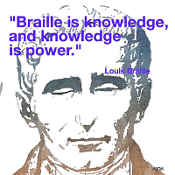"God never creates new conditions for us without giving us the strength to meet them. I am grateful that blindness has not allowed me to forget this." ~ Jacques Lusseyran

Born on this day in Coupvray, France, inventor Louis Braille (1809-1852) transformed a tragic accident that left him blind at the age of four into the creation of the Braille system of printing and writing for the blind.
The system was a simplified version of Charles Barbier's military coding method for sending and receiving messages in the dark.
The Braille touch reading uses six raised dots positioned in a two-column rectangle with three dots each, in 64 possible combinations.
Braille was only 12 years old when he developed this remarkable system.
With passionate dedication, he worked on his alphabet of raised code for three years. In 1829, at the age 20, he published Method of Writing Words, Music, and Plain Songs by Means of Dots, for Use by the Blind and Arranged for Them.
He later applied Braille to the reading of music and mathematics.
Today almost every country in the world uses Braille, which offers those who cannot see a chance to read and write. (Legal blindness is defined as having vision of 20/200 or less).
In 2014, the World Health Organization estimated that worldwide 39 million people are blind and 246 have low vision.
"Braille mastery and reading and writing are central to the success for anyone in the world, particularly for blind and visually impaired people," said Amy Ruell, director of the Braille Press.
"Unless people can read and write and communicate clearly, there's no opportunity for them to compete equally among sighted people."
Today is also World Braille Day, a celebration to honor the genius of Louis Braille who once said, "Braille is knowledge, and knowledge is power."